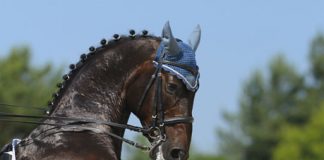
Q: Why do some horses feel threatened when it comes to their food and behave in an aggressive way at meal times? What can I do to prevent food-time aggression and stay safe at feeding time?
When horses establish who’s in charge in the herd, they show they are dominant by controlling space and controlling resources. The resources are food, water and shelter. With food aggression, the horse is often simultaneously invading your space and taking away the food. That’s his way to control space and resources all at once. Keep in mind that he doesn’t know the difference between horse food and people food—he doesn’t know you won’t eat it. He knows he wants it and he can take it from you.
Hand feeding treats can also lead to the horse thinking he is in charge and allowed to take food from your hand. He learns that by pushing into you, he can control where you stand and where you’ll go. Sometimes horses develop food aggression just because their dominant behavior has been tolerated in the past; then it becomes worse over time. Sometimes aggression develops when feeders don’t go into the pen with the horse at all. When horses are fed only twice a day (instead of eating all day long like nature intended), there is a lot of stress and anxiety over when the next meals comes.
Some horses will be so anxious that they start acting out, like pawing, pinning their ears or baring teeth. Then when you dump the hay in, the horse comes to believe his aggressive gestures are causing you to feed him. Even though you aren’t going into the pen, so his gestures don’t concern you, to him it’s as if he intimidated you into dropping the food and leaving, so his aggressive gestures were rewarded.
There is also herd stress if you’re feeding in a group and only feeding twice a day. Horses may be worried about getting their food and also worried if another horse will allow them to eat. Those two factors—the herd and the limited food resource—may make the horses aggressive toward one another as well as anyone present at feed time. In that case, I would recommend separating them for feeding to reduce the competition for food, or feeding more often.
If a horse is acting out toward you as you bring the food, that’s easy to fix. I would use a fabric flag on a stick whenever I approach the horse’s pen, whether I intend to go into it or not. Wave the flag at the horse to back him up. Once he yields his space, he will then look forward at you to see what’s going to happen next. While his ears are forward and after he has backed up, drop the food and walk away. If his aggressive antics don’t get him what he wants, he will stop acting that way. Make sure you have a flag or stick so you can defend yourself.
Remember, he doesn’t have to behave well for long—he just has to behave right at the moment you feed him. It’s not that the alpha horse never lets the other horses eat; they just have to wait until she walks away from the food.
JULIE GOODNIGHT shares her lessons on her RFD-TV show, Horse Master (also online at tv.juliegoodnight.com), and through clinics and expos. HEIDI MELOCCO (www.whole-picture.com) is a lifelong horsewoman, equine journalist, and photographer.
This article originally appeared in the January 2016 issue of Horse Illustrated magazine. Click here to subscribe!





